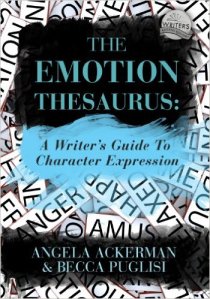I know I have a difficult time showing rather than telling my characters’ emotions. And I know I tend to describe emotions the same way every time even though each scene and each character might be different. The last chapter with Terk and Jako is a perfect example. So when the book The Emotion Thesaurus: A Writer’s Guide to Character Expression was recommended to me, I ordered it right away.
COMMON PROBLEMS TO WRITING EMOTIONS
Telling
Before the book gets into the emotions, it gives some tips for avoiding common problems with writing emotions. The problem I have was listed first, which is basically telling rather than showing. In chapter 11 of part two, a sentence reads, “He glowered at Jako and the weasel of a man finally had the sense to begin feeling uneasy.” Even though Terk can sense emotions, it might be more beneficial for the reader if I showed this part rather than just stated it.
Clichés
Another problem The Emotion Thesaurus mentions is with clichéd emotions. Grinning ear-to-ear is an example the book presents. So when a writer wants to show that a character has a wide grin, perhaps they should try to show it in a different way, or at least a way that is not overly common. My problem isn’t so much a trouble with clichés as it is with using the same expression too much. For example, chapter 11 seems to have a lot of scowling and glowering.
Not Balanced
Too much reliance on either dialogue or non-verbal expression is another problem The Emotion Thesaurus mentions. A writer needs to have both well balanced together. My problem is that my dialogue isn’t balanced well enough with the non-verbal expressions. In other words, the characters talk, but no one feels anything. Or if they do feel something, it is barely mentioned.
The Emotion Thesaurus mentions two more common problems with writing emotions, but I’ll let you buy the book and learn about them for yourself. The book also gives some very good examples of each problem and how to fix them.
THE EMOTION THESAURUS
The rest of the book is the emotions part of the thesaurus. Emotions are listed in alphabetical order from adoration to worry. There are 75 emotions total and each one is broken down into the following parts:
Definition
The definition is first. Some emotions, like embarrassment and shame, are synonyms. But there may be some slight differences that are important for a writer to distinguish between.
Physical Signals
The next section is the emotion’s physical signals. These are the signals that other people can see. There are a number of physical signals for anger including flaring nostrils, glaring, baring one’s teeth, turning red, pounding fist, and so on. Terk was partially angry and he showed it with his glaring and he smacked his hand down. But I could show a little more. He was also annoyed that Jako wasn’t afraid of him. I stated this, but perhaps this thesaurus can help me show it instead.
Internal Sensations
The next section is on internal sensations. These are things a character feels but doesn’t necessarily show. Depending on how angry a character is, their internal sensations can include sweating, quivering muscles, and more.
Mental Responses
The Emotion Thesaurus also lists the mental responses for a character. A character who is angry might also be irritable or irrational, among other things.
Long Term Consequences
If a character feels an emotion for a long period of time, The Emotion Thesaurus lists the cues for this as well. So someone who is angry for a long time, for example, might develop a problem with getting angry over little things, develop hypertension, or escalate into rage.
Suppressed Emotion
But what if a character feels an emotion but tries to suppress it? The Emotion Thesaurus covers this as well. Jori and Terk both have a tendency to try to hide their emotions. So if Terk wanted to suppress his anger, he might try to carefully control his tone, avoid eye contact, or clench his fists behind his back so someone like his father doesn’t notice.
Writing Tip
Each emotion ends with an additional writing tip. Some of the tips are specific to the emotion just presented while other tips can be applied in a number of situations.
CONCLUSION
For me, the three issues first mentioned all boil down to the fact that I do not show my characters’ emotions to the reader well enough. My writing isn’t balanced because I don’t show it and I tend to rely too much on common expressions. I really think The Emotion Thesaurus can help me. Rewriting part one with this in mind might make a huge difference when it comes to developing my characters better. But before I go back that far, I am going to rewrite chapter 11 of part two. Come back next week to see if I’ve made a noticeable difference. In the meantime, buy The Emotion Thesaurus from my Amazon A-Store.


